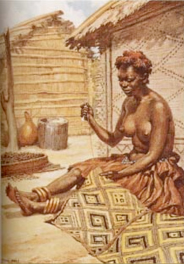Fabrics
Kuba cloths from the Kuba peoples of the Congo
These genuine and highly prized clothes are made out of cut pile raffia and were used for dance skirts, prestige and currency.
The embroidered and appliqué decorated raffia cloths of the Kuba peoples of the Kasai river region of the Democratic Republic of Congo (formerly Zaire) are the best known survivors of an ancient African tradition of fine quality raffia cloth weaving that was once widespread across the whole of Central Africa.
The basic unit of Kuba weaving is the plain square of undecorated raffia cloth, the mbal, woven by men on a type of upright single-heddle loom. The most laborious and prestigious type of cloth decoration, cut-pile embroidery is only produced by women. The raffia thread is prepared by the use of local plant dyes which produced shades of red, blue, black, and yellow. A needle is used to insert a strand of raffia into the plain square of cloth in such a way that it goes under a crossover between a single warp and weft thread, then is drawn up again until the end of the strand on the cloth surface is only one or two millimetres long. Using a small very sharp knife the strand is cut equally close to the cloth leaving two very short tufts. There is no knot, it is simply the tightness of the weave that holds the stitch in place. The process is repeated again and again until a linear block of the same colour has been completed. By rubbing over the tufts with the edge of a knife the ends are split and fluffed out so that the ground cloth is completely concealed by the pile. It is said to take about a month of regular work for a woman to complete a small square of embroidery using this technique. Except with novices, the design to be embroidered is worked out as she proceeds, usually elaborating a new combination of familiar existing designs, without any overall plan being laid out on the cloth in advance.
The designs used by women expert in the embroidery of cut-pile cloth are drawn from a huge repertoire of known patterns, at least two hundred of which have been identified by name.

A woman embroidering cut-pile cloth. Painting by Norman Hardy, from E.Torday & T.A.Joyce, Notes Ethnographiques, 1910-11.
Sabahar
Handmade Ethiopian silk scarves
Ethiopia has a rich tradition of skilled weaving. The introduction of sericulture has a great potential to augment the Ethiopian craft sector. Silk can be produced by households providing a reliable income for skilled artisans. Our silk scarves are made by the women and men of Sabahar in Addis Ababa, Ethiopia, using locally grown silk, hand spun, hand woven and dyed using natural dyes.
The combination of organically produced, hand-spun ‘wild’ silk, and the rich and ancient weaving traditions of Ethiopia result in an exquisite offering of textiles.
Sabahar – it’s all in a name…‘Saba’ was the name of the famous Queen Makeda of Ethiopia (also known as the Queen of Sheba). ‘Har’ means silk in Amharic – the National language of Ethiopia.
Netala
Netalas are the traditional white Ethiopian shawl, trimmed in the Ethiopian colours which have become identified with the whole of Africa: red, yellow and green. These scarves are worn on celebration days.
Table Cloths & Napkins
Pure cotton, handspun and woven, each with an individual traditional embroidered design.
Traditional Sidamo Cloth
Used for garments worn particularly during coffee making ceremonies, in rich browns and yellows.


